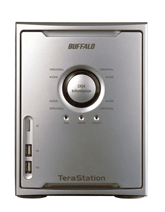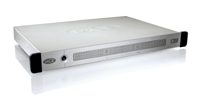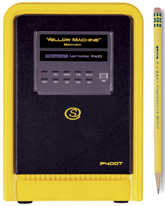With file sizes out of control, storage space on a network is becoming a valuable commodity again. PowerPoint presentations, PhotoShop files and even Excel spreadsheets can be several to hundreds of megabytes in size. Multiply that by the number of users on a network and it's not long before the network administrator sends out a panicked note saying storage on the network is running low.Traditionally, the way to increase capacity has been to add a server with a large hard drive. But this can be both tedious and expensive. A better way to boost storage quickly is by adding a network at- tached storage device. These products are de- signed to be mostly plug and play. Simply attach the device to a network cable on your back end and, in theory anyway, you're good to go.Two recent developments are making simple NAS devices more attractive. First, prices are dropping fast. Second, it's now fairly common to see terabyte drive sizes. Vendors are achieving this by stringing together several physical disks and configuring them as a logical drive in a variety of RAID storage configurations.The GCN Lab sampled four high-capacity NAS devices, from affordable all-in-one units to highly redundant rack-mountable systems. We graded based on several factors, not the least of which was each device's ability to quickly transfer 19.7G worth of test data over a standard Ethernet connection. We also considered how easy it was to configure the devices, any extra features that came with each NAS and overall bang for the buck.As with so many other technology decisions, the NAS device you purchase depends on what you want to accomplish. For example, Anthology Solutions' Yellow Machine P400T could be ideal in a small office. Not only does it provide 1TB of network storage, it also has built-in Internet routing and an eight-port LAN switch. For storing and backing up mission-critical data, there's the pricier Idealstor FrankeNAS with its redundant primary drives and pair of removable backups.If all you're looking for is the quickest and easiest way of adding network storage, you may opt for the no-frills Buffalo TeraStation, which can handle Gigabit Ethernet as well as extra-large data packets. And for the best overall combination of price, performance and ease of use, we'd suggest our Reviewer's Choice, the LaCie Ethernet Disk.It's worth noting, however, that the NAS landscape is a rich one. We invited Dell, EMC and Hewlett-Packard to participate in our review, but each declined. Dell couldn't get us a test unit in time and HP was in the process of releasing a new NAS product. So do your homework and test drive some of these models before taking the plunge.[IMGCAP(4)] Built-in switch and router, compact Slow transfer speeds C A B+ BAnthology Solutions' P400T Yellow Machine is a small, freestanding unit that comes with a fair number of features not often found in a typical NAS. Even though some of these extras are a bit unusual, they could be useful in small office settings.The Yellow Machine combines storage, Internet routing and LAN distribution into one little yellow box. Its four 250GB ATA drives can be set to work in a variety of RAID configurations. It comes factory set in RAID 5, which is the most popular configuration, but can be changed to RAID 0, 1, or 1+0 using the bundled administration software, which is surprisingly simple to use. It has a good, intuitive interface that can be accessed remotely over an IP network. Of course, you will want to set the RAID configuration you would like to use before you start to copy any data, because changing the configuration reformats the drives. To its credit, the software warns you of this'a nice touch for small offices where network administration experts may be in short supply.The manual suggests first connecting the Yellow Machine to a single computer because it ships with a static IP that will need to be changed before it's easily seen on the network. Doing so is fairly simple, as is accessing the system's setting though a Web browser. Once the IP and other settings are changed, it isn't difficult to connect it to the network and start using it as a file-share device. Overall, getting the Yellow Machine running on the network requires more steps than some other models in this review, but it doesn't require specialized training.The administration software also has the ability to keep track of users and their security levels. You can restrict Internet access to certain subfolders, which is important if you plan to use the unit's WAN port as a gateway to the outside world. As an added layer of protection, the Yellow Box has an integrated packet inspection firewall and proxy server.Unfortunately, we could not get the Yellow Machine to interface with Active Directory, so if you're already controlling security by some other means, it may take some juggling to apply those measures to this device.In our file transfer tests, the Yellow Machine was the slowest in the review, with an average transfer rate of 13.02 Mbps copying our 19.7GB data folder. Moving the files took over nine hours, which was three hours longer than any other system we tested.The Yellow Machine's list price of $1,299 might seem a bit steep, but when you consider the built-in LAN switch and NAT Router, the price is more reasonable. Still, it's not the best bargain out there.Small offices with little or no existing network infrastructure might appreciate Yellow Machine's all-in-one design. But a large office with a highly integrated network in place might find that its features get in the way and actually limit the Yellow Machine's effectiveness.Anthology Solutions Inc., Santa Clara, Calif., 877-936-5600, Easy setup, Gigabit Ethernet Few extra features B B- A A-If your network is rapidly running out of space, the TeraStation from Buffalo Technology could come to the rescue in a hurry. There is literally nothing you must do to get it up and running besides plug it into a network and turn it on. Although it defaults to a RAID 0 configuration, you can use software to change it to either RAID 1 or 5.The unit is a freestanding model and looks exactly like those little toy safes you give to children, only the safe's dial is a series of blinking lights that tell you at a glance if all four of the internal drives are healthy and operating. It's quite small, at only 6.6 inches wide and 9 inches tall, so even though it won't fit into a server rack, you can probably find a tiny space to stash it somewhere in your server room. You could also stack several of the cubes together.The $799 price tag is attractive, but the TeraStation we tested had only 600GB of storage. That is still a lot of capacity to add to a network, especially when you consider how easy it is to set up. There are TeraStation models with a full terabyte of capacity that we found online for about $1,000.In our performance tests, the TeraStation was middle-of-the-road, beating the Yellow Machine by more than three hours, but lagging slightly behind the two faster devices. With a transfer time of 6 hours and 27 minutes, the TeraStation averaged 18.5 Mbps.But the TeraStation has an ace up its sleeve that might make it attractive to agencies that have moved toward more modern network technology. It has a Gigabit Ethernet port with jumbo frame support. Jum- bo frames mean the TeraStation can handle larger packets than a regular Ethernet system. We used standard Ethernet connections in our testing to establish a level playing field. But if your agency has moved to Gigabit Ethernet, expect file transfer speeds to increase significantly.With support for faster technology, the TeraStation is a good choice if you're on a tight budget and need additional network storage in a hurry.Buffalo Technology Inc., Austin, Texas, 866-456-9799, [IMGCAP(2)] Fast transfer rates, removable PATA drives for backup Expensive A A B- B-Now for something different. Because it's almost Halloween, we thought we'd take a look at the aptly named FrankeNAS from Idealstor. The FrankeNAS is huge, taking up four units of space in a standard server rack. This may seem like a lot compared with the tiny competitors, but the reason is that the FrankeNAS is actually two storage appliances in one.One side of the device is a five-disk array configured to the highly secure RAID 5 format. Unlike the mini units in this review, all the disks are easily accessible'not encased and hidden. Thanks to the redundant nature of RAID 5, if one of the drives fails, it can be swapped out for a good disk with very little chance of losing data.The other side of the FrankeNAS comprises two removable parallel ATA backup drives. You can configure the system to automatically back up data to the PATA drives at intervals or trigger a full backup using the software interface. The FrankeNAS is the only system to use the Windows 2003 Server OS, so if you're familiar with it, the commands and capabilities will be second nature. If not, there are several so-called 'links' you can click on to make the server perform different tasks or schedule backups.The PATA drives are easy to eject. They are square blocks with convenient carrying handles that can easily be slipped into a large envelope and sent to an off-site storage facility. Popping in a new PATA drive is as easy as lining up a dresser drawer and pushing lightly.In fact, the FrankeNAS is all about redundancy. In ad- dition to the PATA drives, there are also two redundant pow- er supplies. You can lose one completely and the NAS still operates. Your users won't experience any downtime or data loss as a result.In our performance testing, the FrankeNAS was the outright fastest of the group, transferring our 19.7GB test folder in five hours and 57 minutes. That's an average transfer rate of just over 20 Mbps. Like the TeraStation, the FrankeNAS also has the capability to handle gigabit networking, which would further increase its speedy performance.As you might expect, the speed, redundancy and flexibility the FrankeNAS offers comes at a price'$13,495. Yes, there are many cheaper ways to get your hands on 1TB of storage.But if the data you're backing up is mission-critical, or if you don't already have a networkwide storage backup plan in place, then the FrankeNAS will let you sleep comfortably at night, knowing your data is protected. It may be a monster, but one that will keep your data safe.Idealstor LLC, Gaithersburg, Md., 888-864-3257, [IMGCAP(3)] Good performance, affordable, easy to use No redundancy A- B A- AThe LaCie Ethernet Disk is a somewhat bare-bones unit that can quickly add a terabyte of storage to a network. If your primary need is simple storage and you don't need a lot of extra features or don't want to get bogged down trying to administer them, then this is the best choice.The Ethernet Disk comes configured for RAID 0, which makes maximum use of its available space, but is not redundant at all. And there is no way to change this configuration with the included software.That said, RAID 0 is the easiest of RAID levels to manage because the entire device is treated by the OS as a giant, single hard drive. Combine that with a Windows XP Embedded OS and you have one easy appliance to manage.In terms of performance, the Ethernet disk did quite well. It was able to transfer 19.7G in six hours and nine minutes. Its average transfer rate of 19.41Mbps was just slightly less than the fastest NAS in the review. Not bad for a $1,000 network device.If you need more speed and your network can handle it, there is a similarly priced LaCie Ethernet Disk that comes with Gigabit Ethernet and scales to 2TB. The model we tested had two USB ports, a FireWire 400 port and the standard 10/100 Ethernet jack.LaCie's 1U rackmount NAS is extremely thin and only 12 inches wide. There is only one button on the front, which is used to power the unit on or safely shut it down. It's designed to plug into a network, add a terabyte of storage and then be left alone.The all-around good performance, fair price, ease of use and ability to quickly add storage to almost any network configuration make the LaCie Ethernet Disk our Reviewer's Choice.LaCie USA, Hillsboro, Ore., 503-844-4502,
Buffalo's TeraStation is a snap to set up.
The FrankeNAS is a RAID 5 appliance with a pair of backup PATA drives.
LaCie's Ethernet Disk slips into a 1U rack.
The tiny Yellow Machine still packs 1TB of storage.










